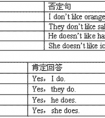选出有错误的一项。( )1. It's time for go to school. A B C( )2. It's nine oclock.A B C( )3. I have ten clock. AB C( )4. It's time for english class. A -四年级英语
1. 表示几点钟用基数词加可以省略的o’clock
5:00 读作 five o’clock 或 five
2. 表示几点过几分,可以直接读,也可以在分钟后加past,再加小时。但分钟数必须在半小时以内(含半小时)。
five past seven 七点过五分
half past six 六点半
a quarter past eight 八点过一刻
seven past eight 八点过七分
3. 表示几点差几分,在分钟后面加to,再加小时。但分钟必须在半小时以上(不含半小时)。
ten to eight 差十分八点(七点五十分)
a quarter to twelve 差一刻十二点(十一点四十五分)
twenty to six 差二十分六点(五点四十分)
4、时刻前通常加at。如:at seven, at ten twenty
在日常生活中,常用下列简单方法表示时间。
以小时、分钟为单位分别读出数字。
6:31 读作 six thirty-one
10:26读作 ten twenty-six
14:03 读作 fourteen o three
16:15 读作 sixteen fifteen
18:30 读作 eighteen thirty
23:55 读作 twenty-three fifty-five
注:时刻表上的时间大多采用24小时表示法,这样就不需要用a.m.表示上午,p.m.表示下午了。
时间的读法有以下一些特点:
(1) 可以直接按照表示时间的数字来读。
10:56读作 ten fifty six
8:30读作 eight thirty
(2) 正点后的前半小时,通常说几点“过”(past)几分。
9:25读作 twenty-five past nine
2:16读作 sixteen past two
(3) 正点后的后半小时,通常说几点“差”(to)几分。此时,所说的“几点”指的是“正点”后的下一个“正点”。
10:55读作 five to eleven
8:40读作 twenty to nine
(4) 英语中的15分钟也可以说成“一刻钟”(a quarter)。
4:15读作 a quarter past four
7:45读作 a quarter to eight
英语时刻表示法:
(1) 二十四小时计时法
二十四小时计时法通常采用“小时数:分钟数”、“小时数.分钟数”或“小时数分钟数”的形式,如:
01:00 凌晨一点 (ou) one hour或one o'clock
01:20 凌晨一点二十分 (ou) one twenty或twenty past one
02:00 凌晨两点 (ou)two hours或two o'clock
02:10 凌晨两点十分 (ou) two ten或ten past two
3:05 凌晨三点五分 (ou) three(ou) five 或five past three
09:45 上午九点四十五 (ou) nine forty-five 或a quarter to ten
10:15 上午十点一刻 ten fifteen或a quarter past ten
12:00 中午十二点 twelve hours或midday或noon
12:45 中午十二点四十五 twelve forty-five或 a quarter to thirteen
13:00 下午一点 thirteen hours
15:30 下午三点半 fifteen thirty或half past fifteen
21:15 晚上九点一刻 twenty one fifteen
23:00 晚上十一点 twenty-three hours
23:05 晚上十一点零五分 twenty-three(ou)five
23:45 晚上十一点四十五分 twenty-three forty-five
00:00 零点 midnight或zero hour
00:15 零点十五分 midnight fifteen或zero hour fifteen
00:30 零点三十分 midnight thirty或zero hour thirty
(2)十二小时计时法
十二小时计时法通常采用“小时数:分钟数” 或“小时数.分钟数”的形式,
如:8:12或8.12。为了避免误解,通常加上in the morning / a.m.(上午)或in the afternoon p.m.(下午)以示区别。
a.m.是拉丁语 ante meridiem的缩写形式,读作/'ei'em /,意思是“上午”;
p.m.是拉丁语post meridiem的缩写形式,意思是“下午;晚上”,读作/'pi:'em/。若表示整点钟,可加o'clock,也可不加。如:
8.00 a.m./8:00 a.m. 上午八点
读作:eight a.m. 或 eight in the morning.
8.45 a.m./8:45 a.m. 上午八点四十五
读作:eight forty-five a.m. 或 a quarter to nine in the morning.
2.00 p.m./2:00 p.m. 下午两点
读作:two(o'clock) p.m. 或 two (o'clock) in the afternoon.
3.30 p.m./3:30 p.m. 下午三点半
读作:three thirty p/m. 或 half past three in the afternoon
5.15 p.m./5:15 p.m. 下午五点一刻
读作:five fifteen p.m. 或 a quarter past five in the afternoon.
8.55 p.m./8:55 p.m. 晚上八点五十五
读作:eight fifty-five at night 或 five to nine at night (at night指日落后到半夜零时。)
考点名称:实义动词
实义动词:
与系动词是相对的,系动词亦称连系动词,作为系动词,它本身有词义,但不能单独用作谓语,后边必须跟表语(亦称补语),构成系表结构说明主语的状况、性质、特征等情况。
实义动词意思完全,能独立用作谓语。
实义动词有及物动词和不及物动词(及物动词是指后面要求有直接宾语的动词;
不及物动词指后面不需要跟宾语的动词)即行为动词,表示动作的动词。
实义动词(又称行为动词):表示行为或状态,有完全的词义,能独立作谓语。
如:I go to school by bus. 我乘公交车去上学。
The students clean their classroom every day. 学生每天打扫教室。- 及物动词:
后面必须跟宾语,意义才完整的实义动词,叫做及物动词(transitive verb)。
英语中的及物动词有:interest,worry,guss,please,surprise,love等
例如:I believe that the committee will consider our suggestion.我相信委员会将会考虑我们的建议。
“How long can I keep the book ”Harry asked.哈里问:“这本书我可以借多久?”
Dr. Bethune set us a good example. 白求恩大夫给我们树立了好榜样。
Crude oil contains many useful substances.原油含有许多有用的物质。
不及物动词:
本身意义完整,后面不用跟宾语的实义动词,叫做不及物动词(intransitive verb)。
Birds fly.鸟会飞。
It happened in June 1932.这件事发生于一九三二年六月。
My watch stopped.我的表停了。
She spoke at the meeting yesterday evening. 她在昨天晚上的会上发了言。
兼作及物动词和不及物动词:
英语里有不少实义动词可以兼作及物动词和不及物动词。
这样的动词又有两种不同的情况:
a)兼作及物动词和不及物动词时,意义不变。试比较:
Shall I begin at once?我可以立刻开始吗?(begin作不及物动词)
She began working as a librarian after she left school.她毕业后当图书馆管理员。(began作及物动词)
When did they leave Chicago?他们是什么时候离开芝加哥的?(leave 作及物动词)
They left last week. 他们是上周离开的。(left 作不及物动词)
b)兼作及物动词和不及物动词时,有时意义不尽相同。如:
Wash your hands before meals.饭前要洗手。
Does this cloth wash well? 这布经得起洗吗?
与汉语的比较:
有时英语动词的及物和不及物的用法,与汉语的用法完全不一样,请注意下列两种情况:
a)有的动词在英语里只能用作不及物动词,而汉语则可用作及物动词,如arrive到达,agree同意,listen听。英语里这些动词后面常接介词。如:
We arrived at the railway station at noon.我们于中午到达火车站。(at不能省去)(比较:We reached the railway station at noon.)
Everybody listened to the lecture with great interest.每个人都很有兴趣地听讲课。(to不可省去)(比较:We all heard the lecture.)
Do they agree to the plan?他们同意这个计划吗?(to不可以省去)
b)有的动词在英语里能用作及物动词,而在汉语里则不能用作及物动词,如serve为…服务。
Our children are taught to serve the people wholeheartedly.我们的儿童被教以全心全意为人民服务 - 特殊实义动词:
英语动词很多既是及物动词又是不及物动词,如
close, begin, study, leave, work等。
①The post office closes at 9:00 p. m.邮局晚上9点关门。
②Close the window,please.请关窗。
③Shall we begin now?我们现在开始吗?
④ Bill began working as a sailor after he left school.比尔毕业后当水手。
⑤They left yesterday.他们昨天离开的。
⑥When did you leave Washington?你什么时候离开华盛顿的?
⑦The students study hard.这些学生学习努力。
⑧The students study English and German.这些学生学习英语和德语。
⑨He works in a supermarket.他在一家超市工作。
⑩He works the machine on Mondays.他星期一操作这台机器。
- 最新内容
- 相关内容
- 网友推荐
- 图文推荐
| [家长教育] 孩子为什么会和父母感情疏离? (2019-07-14) |
| [教师分享] 给远方姐姐的一封信 (2018-11-07) |
| [教师分享] 伸缩门 (2018-11-07) |
| [教师分享] 回家乡 (2018-11-07) |
| [教师分享] 是风味也是人间 (2018-11-07) |
| [教师分享] 一句格言的启示 (2018-11-07) |
| [教师分享] 无规矩不成方圆 (2018-11-07) |
| [教师分享] 第十届全国教育名家论坛有感(二) (2018-11-07) |
| [教师分享] 贪玩的小狗 (2018-11-07) |
| [教师分享] 未命名文章 (2018-11-07) |


![I want to ______________a science teacher one day![ ]A. beB. isC. are-六年级英语](http://www.00-edu.com/d/file/ks/4/1/58/2019-08-28/small0786c619dff6ea7cc013f1222e770e571566922364.png)
![Let's get ____ work![ ]A. on B. inC. to-四年级英语](http://www.00-edu.com/d/file/ks/4/1/58/2019-08-28/smallaeead033e0df4ab64ad92e4eecbe84ed1566922686.png)
![It's 10 o'clock. It's time_________go to school.[ ]A. toB. forC. of-四年级英语](http://www.00-edu.com/d/file/ks/4/1/58/2019-08-28/smallcbd5ebed803baef3505fe0cd5bc985461566922628.jpg)

